- Регистрация
- 17 Февраль 2018
- Сообщения
- 26 764
- Лучшие ответы
- 0
- Баллы
- 2 093
Offline
Intel’s new Lunar Lake hardware is a reflection of modern chip design.
It’s tempting to call it a “processor” or “CPU” — old habits die hard, after all — but it’s really a system-on-a-chip (SoC), both in terms of architecture and philosophy. The CPU cores are joined by integrated GPU cores, a neural processing unit (NPU), and even on-chip RAM. Also, unlike past Intel chips, Lunar Lake seems set on striking a balance between the three.
That’s keenly felt in Intel’s approach to Lunar Lake’s integrated graphics (iGPU). Building on the success of Intel Core Ultra, Intel’s new processors also offer Intel Arc graphics — but this time around, Intel has returned to providing each iGPU a name unique to its configuration, and the best version here is the Intel Arc 140V with eight Xe Cores and a max frequency of 2.05GHz.
Meanwhile, Intel’s competition hasn’t been spinning its wheels. AMD’s latest Ryzen AI processors have their own integrated graphics updates in the form of the Radeon 880M (succeeding the well-respected Radeon 780M) and the new Radeon 890M (which clearly thumped an earlier Intel Arc iteration in our last integrated graphics test).
So, how well does the iGPU in Intel’s Lunar Lake chips perform? Is it a minor boost over previous incarnations? Or a major update? Spoiler alert: Lunar Lake’s visual chops are good enough to let you play many modern games without paying extra for a discrete graphics card. Keep reading for our in-depth benchmark test results.
Updated on November 22, 2024: This article was updated to include benchmark results from the Asus Zenbook S 14 with Intel Core Ultra 7 258V. Additional testing was conducted after initial results suggested the Lenovo Yoga Slim 7i Aura Edition might be delivering lower-than-typical graphics performance for this configuration.
Hardware specifications for our tests
Our game benchmarks below were conducted on two laptops: a Lenovo Yoga Slim 7i Aura Edition with Intel Core Ultra 7 256V processor and an Asus Zenbook S 14 with Intel Core Ultra 7 258V processor.
The Intel Core Ultra 7 processors are high-end Core Ultra 7 chips for slim-and-light laptops, though more mid-range in terms of overall core count and performance (as opposed to, say, the Intel Core Ultra 9 285K). These chips are common choices for thin, light, Intel-powered laptops sold above $1,000. Cheaper laptops may offer them as upgrades.
While neither the Intel Core Ultra 7 256V nor 258V are the most powerful SKUs in Intel’s latest line-up, their iGPU looks impressive on paper. Both are badged as Intel Arc 140V, which is the best version of Arc integrated graphics in the Lunar Lake line-up. They have eight Intel Xe Cores, the same number as higher Lunar Lake SKUs.
With that out of the way, let’s get to the benchmarks.
3DMark
Let’s start things off with 3DMark’s Time Spy and Night Raid tests. Time Spy is a more demanding (but still not especially punishing) benchmark while Night Raid is a less demanding benchmark meant for entry-level graphics hardware, including integrated graphics.
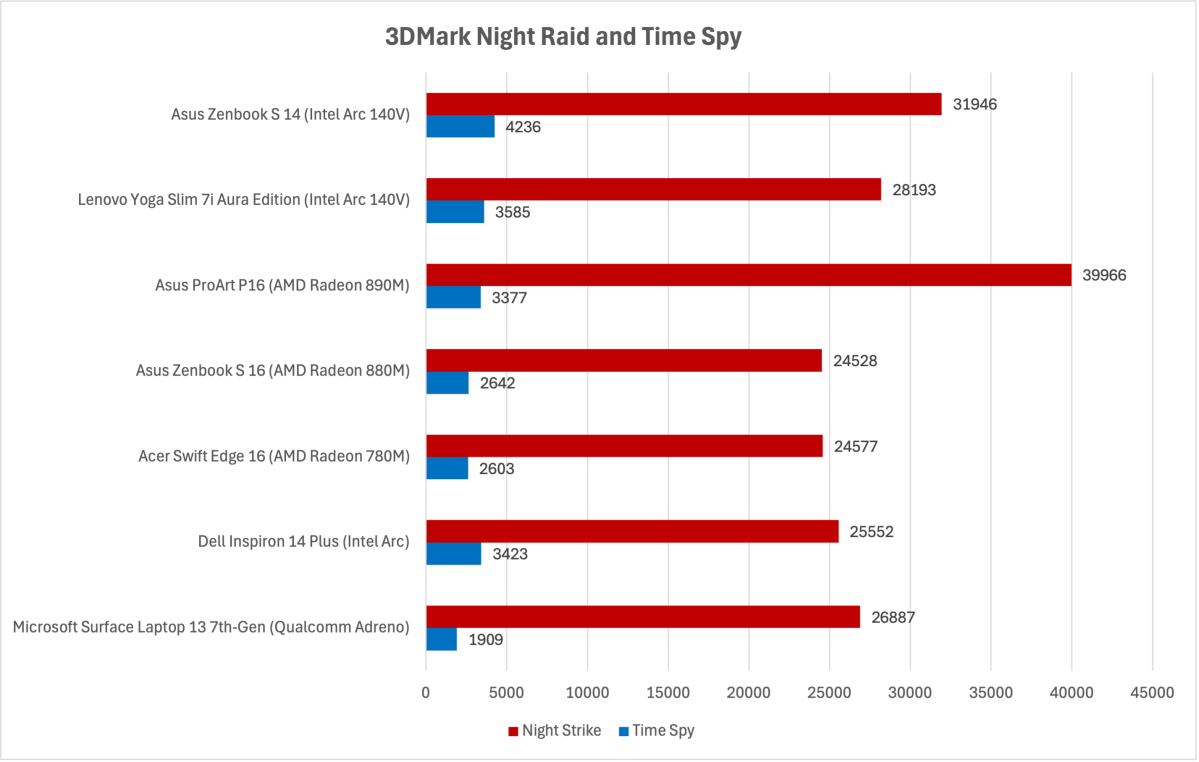
Matthew Smith / IDG
The Asus Zenbook S 14’s Arc 140V shows strong synthetic benchmark performance, scoring 31,946 in Night Raid and 4,236 in Time Spy. That’s a big improvement over the Lenovo Yoga Slim 7i Aura Edition’s results of 28,193 and 3,585, respectively.
While the Zenbook puts Intel closer to competing with AMD’s Radeon 890M, AMD still maintains an advantage of 39,966 in Night Raid, though it falls behind in Time Spy. That suggests we’ll see varied results in actual games, with Asus’ implementation providing stronger performance than our initial Lenovo test unit.
Onward, to the games!
Sid Meier’s Civilization VI
Let’s give a polite round of applause to Civilization VI. First released in October 2016, the game is now eight years old — and over the course of that journey, it has roughly doubled its active player base since the months following its launch (based on publicly available Steam stats).
With Civilization VII due out in 2025, the sun is setting on this title. But, at the moment, it’s still by far the most popular and commercially successful entry in the Civilization franchise.
It’s also a less demanding game that’s playable even when frame rates dip below 30 FPS, which makes it easy to enjoy on mid-range, thin-and-light laptops with integrated graphics.
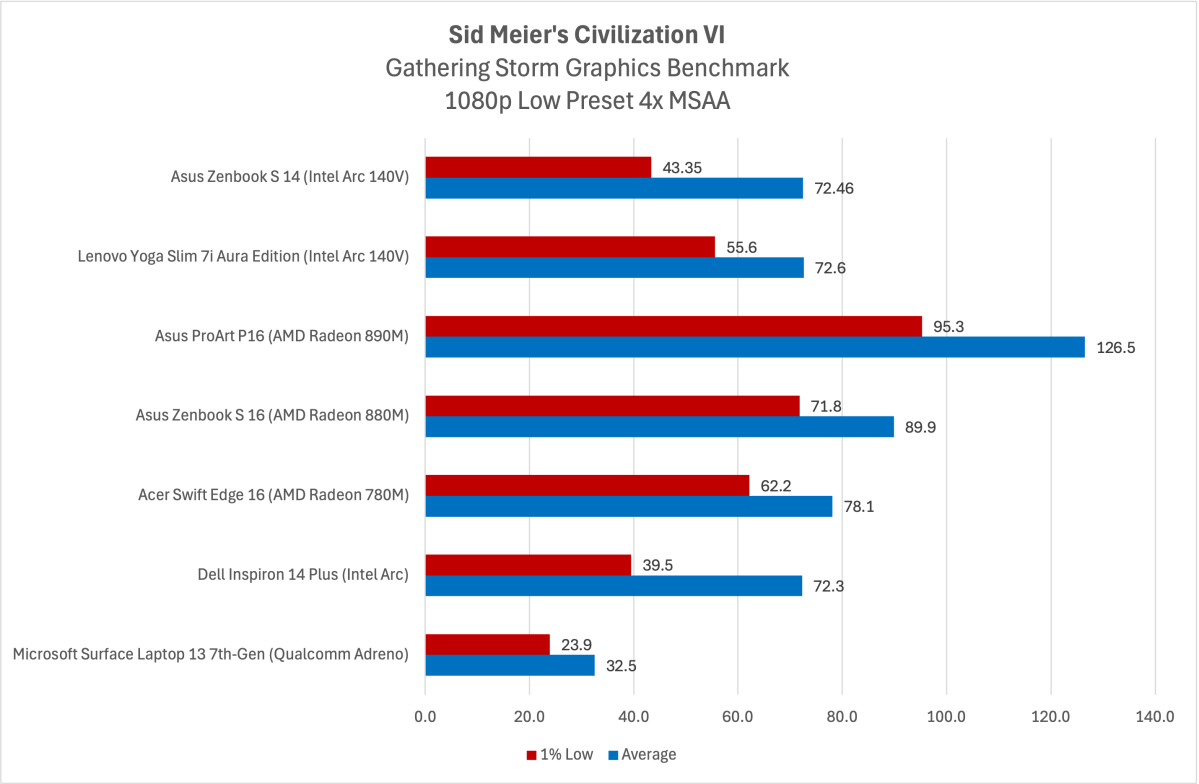
Matthew Smith / IDG
The Asus Zenbook’s Arc 140V delivers 72.46 FPS average with 43.35 FPS 1% lows. While this matches the Lenovo’s average frame rate of 72.6 FPS, the improved 1% low (compared to Lenovo’s 55.6 FPS) suggests more stable performance.
However, both Intel Arc 140V laptops trail significantly behind AMD’s Radeon 890M and Radeon 880M, which average 126.5 and 89.9 FPS, respectively. Even the older Radeon 780M beats Intel’s Arc 140V by a few frames per second. That’s a huge advantage for AMD in this title.
Dota 2
Although not often discussed in “mainstream” gaming news, Dota 2 still typically sits among the top three games on Steam and has a vibrant esports scene. It’s also the least demanding game used for this test.

Matthew Smith / IDG
Dota 2‘s average frame rate sees another marginal uplift for the Intel Arc 140V. Though it churned out a slightly better average frame rate, its advantage comes down to just a handful of frames, which is trivial in a game that averages above 100 FPS.
The minimum frame rate is more impactful. The Asus Zenbook S 14 beat a 1% low of 60 FPS, which means it can generally achieve 60 FPS or better in even the most demanding scenes. Intel Arc 140V beat the 1% lows from the AMD Radeon 880M and 890M laptops by roughly 10 FPS.
The Lenovo Yoga Slim 7i Aura Edition was not as quick, however, and more-or-less tied its AMD-powered peers.
Final Fantasy XIV
Final Fantasy XIV is a personal favorite and remains among the most popular MMORPGs on the market.
The latest expansion, Dawntrail, brought a graphics update that noticeably improves texture quality and polygon count. That makes it somewhat challenging for iGPUs to handle, though most can deliver an average around 30 FPS or better at High (Laptop) detail.
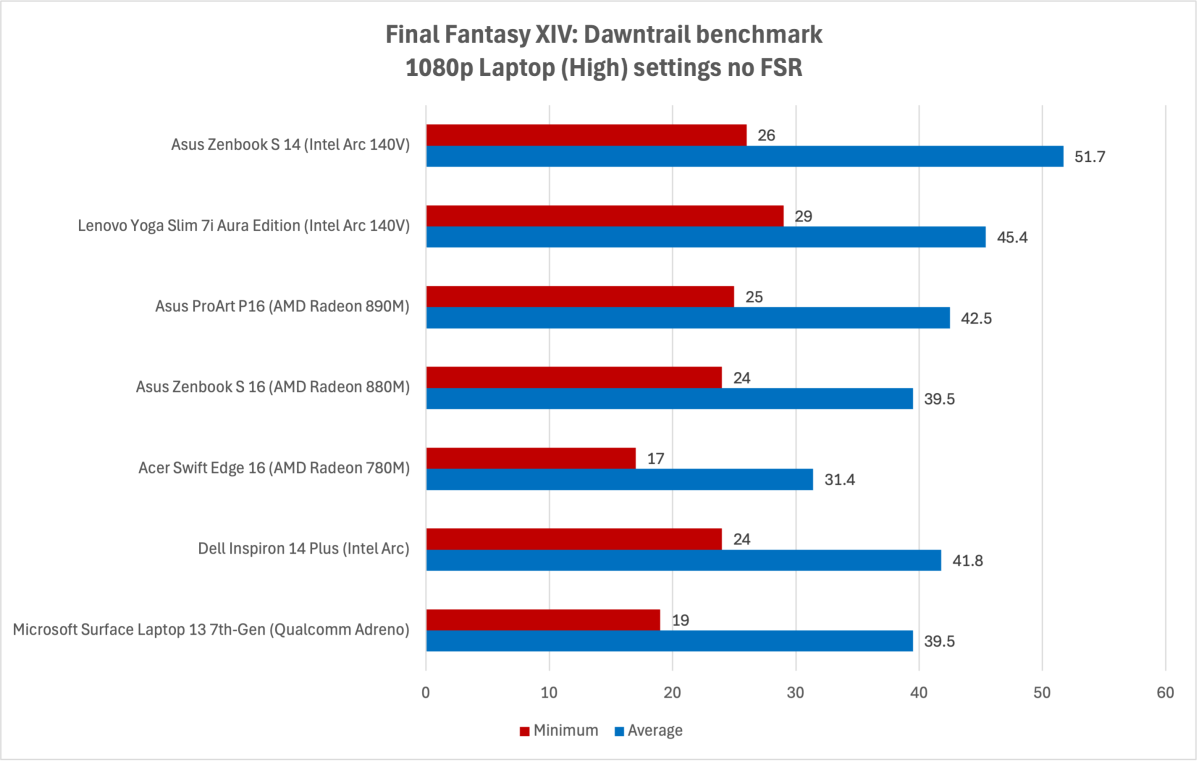
Matthew Smith / IDG
These results are the opposite of what we saw from Civilization VI. The Intel laptops dominate, with the Asus Zenbook S 14 averaging nearly 52 FPS and the Lenovo Yoga Slim 7i Aura Edition averaging about 45 FPS. Both figures leave AMD’s Radeon 890M and Radeon 880M behind.
Total War: Warhammer III
Though it sits in the same grand strategy genre as Civilization, Creative Assembly’s Total War: Warhammer III is far more demanding. It’s enough to challenge the most capable iGPUs, even at just 1080p and the Low detail preset. Intel’s Arc 140V is no exception.

Matthew Smith / IDG
This is a disappointing result for Intel. While the Asus Zenbook S 14 with Intel Arc 140V delivered a small performance boost over the prior generation of Intel Arc, the game still can’t provide a consistent 30 FPS at these settings. The slower Lenovo Yoga Slim 7i Aura Edition is even worse off, as it averaged a tad under 30 FPS.
AMD’s Radeon 890M notches a win here, raising the minimum frame rate above the crucial 30 FPS line. The Radeon 880M, on the other hand, finds itself tied with Intel Arc 140V. It’s playable, I suppose, but barely.
The Elder Scrolls V: Skyrim
Though over 10 years old at this point, The Elder Scrolls V: Skyrim is a game that keeps on giving. It remains popular and, thanks to graphical upgrades in the Special Edition, it’s still somewhat demanding for iGPUs when played at 1080p resolution and High detail.
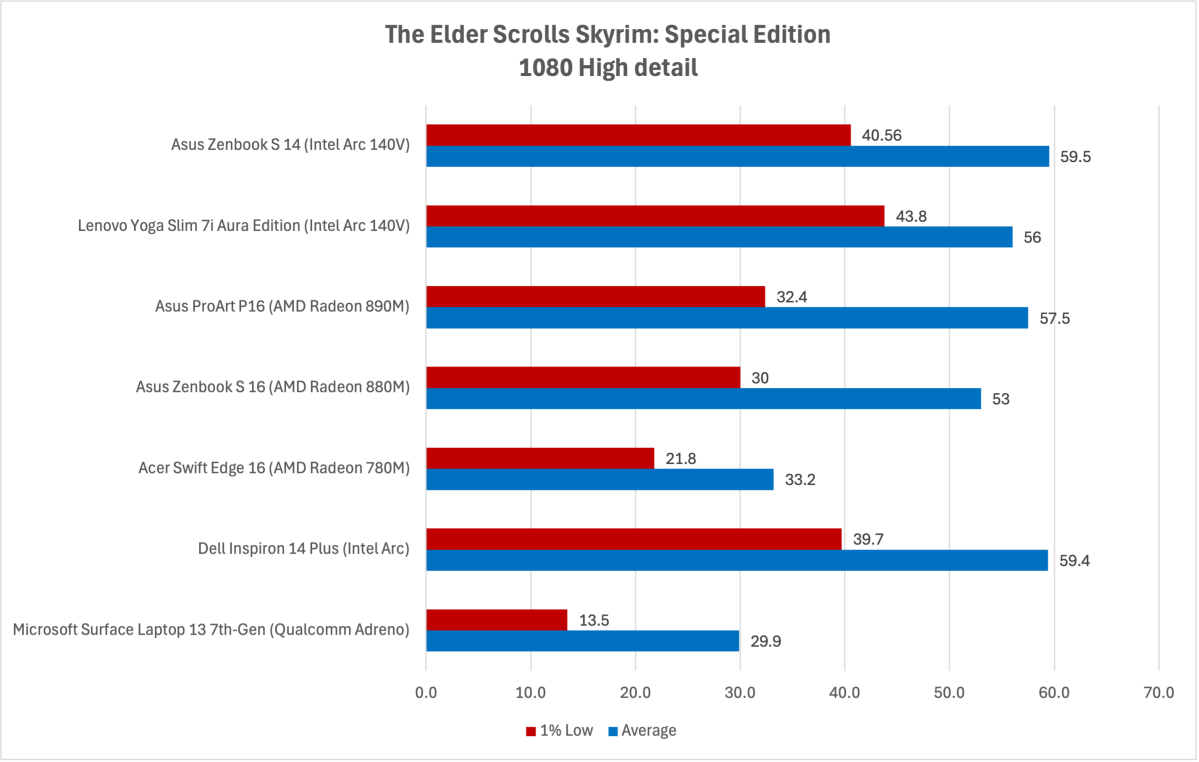
Matthew Smith / IDG
These results are good for Intel. While none exactly hit 60 FPS, it’s important to note the game has a 60 FPS cap. Because of that, it’s the minimum frame rate that matters most — and Intel’s Arc 140V beats both the AMD Radeon 890M and Radeon 880M by that metric.
On the other hand, the older Dell Inspiron 14 Plus with Intel Arc delivered performance very close to the Asus Zenbook S 14 and Lenovo Yoga Slim 7i Aura Edition with Intel Arc 140V. Skyrim plays well on Intel Arc 140V, but Intel’s prior-gen hardware is nearly as good.
Cyberpunk 2077
We finish off with Cyberpunk 2077, a notoriously demanding game that, despite a lackluster launch, has roared back to popularity in part thanks to its visually stunning and immersive world.
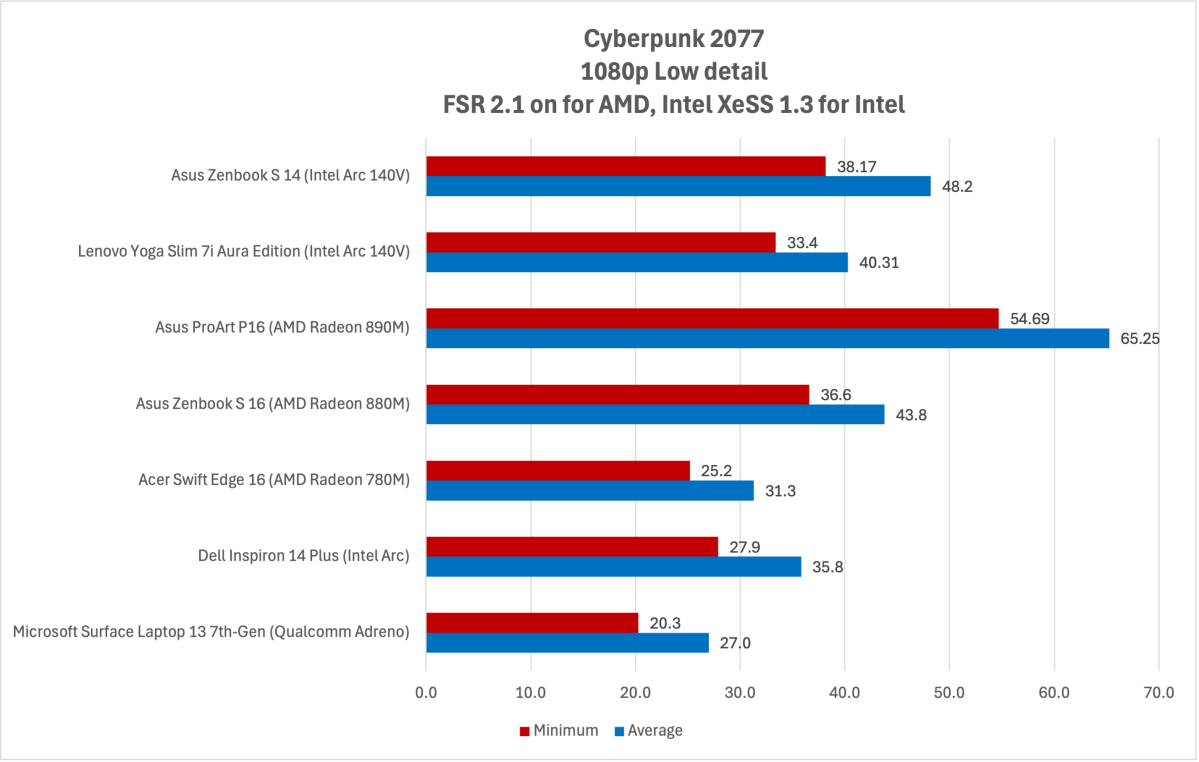
Matthew Smith / IDG
This is a good result for the Intel Arc 140V, which delivers a noticeable improvement over its predecessor.
Asus’ Zenbook S 14 took a clear lead over the Lenovo Yoga Slim 7i Aura Edition, as the Asus averaged about 48 FPS against the Lenovo’s 40 FPS. Compared to the AMD-powered systems, Intel’s Arc 140V seems to edge out the AMD Radeon 880M, but it falls behind the AMD Radeon 890M.
Still, it’s important to note the Intel Arc 140V scored both average and minimum frame rates above 30 FPS at these settings. That means the game should feel playable on Intel’s Arc 140V — which, given how demanding this game can be, is impressive.
Intel Arc 140V performance discussion
Intel’s Arc 140V is definitely superior to the prior-gen Intel Arc offering. How much so depends on the game, but best-case scenarios see that it can increase average frame rates by up to 25 percent.
That would be significant in any case, but it’s especially important for integrated graphics solutions that often struggle to hit the 30 FPS target in modern titles. An extra 25 percent can mean the difference between clearing a minimum frame rate of 30 FPS or falling short a few frames — and that’s exactly what happens in Cyberpunk 2077.
However, not every game saw a noticeable performance boost. Civilization VI was no quicker on the new Intel Arc 140V than it was on an older Dell Inspiron 14 Plus with first-gen Intel Arc. The performance uplift was also rather marginal in Skyrim and Dota 2. To be fair, though, all these games were enjoyable at the settings we used for testing.
We also saw a notable difference in performance between the Asus Zenbook S 14 and Lenovo Yoga Slim 7i Aura Edition. While the former felt like a respectable upgrade over the prior generation, the latter just barely edged ahead.
We’ve also tried other laptops with Intel’s Arc 140V, like the Acer Aspire 14 AI, and we’ve found that performance leans closer to the Asus Zenbook S 14 than the Lenovo Yoga Slim 7i Aura Edition (so far). But this goes to show that, in 2024, you can’t count on a graphics solution to perform similarly across all laptops that use it. You’ll need to read a review of the specific laptop you want to buy.
How does the Intel Arc 140V compare to AMD’s Radeon 880M and Radeon 890M? We’d say the Intel Arc 140V has a general edge over the AMD Radeon 880M but isn’t as quick overall as the AMD Radeon 890M. As mentioned, it depends on the particulars of a given laptop.
The verdict on Intel’s Arc 140V
In summary, the Intel Arc 140V is a good update over prior Intel Arc integrated graphics. It pushes integrated graphics performance in a way that is at times meaningful, especially in more demanding games (like Cyberpunk 2077) that struggle to offer a steady 30 FPS. In other games, like Dota 2, the performance increase is evident in benchmarks but slim enough that it’s hard to notice in real gameplay.
The real winner in all of this, truth be told, is you. Intel Arc and AMD Radeon integrated graphics solutions are competitive, and that competition is forcing both companies to put their best feet forward. In fact, Intel Arc 140V and AMD Radeon 880M/Radeon 890M graphics can now deliver performance that isn’t far behind some laptops with Nvidia GTX 3050 mobile graphics — and thanks to that, there’s a buffet of modestly priced laptops that can handle today’s most popular PC games.
It’s tempting to call it a “processor” or “CPU” — old habits die hard, after all — but it’s really a system-on-a-chip (SoC), both in terms of architecture and philosophy. The CPU cores are joined by integrated GPU cores, a neural processing unit (NPU), and even on-chip RAM. Also, unlike past Intel chips, Lunar Lake seems set on striking a balance between the three.
That’s keenly felt in Intel’s approach to Lunar Lake’s integrated graphics (iGPU). Building on the success of Intel Core Ultra, Intel’s new processors also offer Intel Arc graphics — but this time around, Intel has returned to providing each iGPU a name unique to its configuration, and the best version here is the Intel Arc 140V with eight Xe Cores and a max frequency of 2.05GHz.
Meanwhile, Intel’s competition hasn’t been spinning its wheels. AMD’s latest Ryzen AI processors have their own integrated graphics updates in the form of the Radeon 880M (succeeding the well-respected Radeon 780M) and the new Radeon 890M (which clearly thumped an earlier Intel Arc iteration in our last integrated graphics test).
So, how well does the iGPU in Intel’s Lunar Lake chips perform? Is it a minor boost over previous incarnations? Or a major update? Spoiler alert: Lunar Lake’s visual chops are good enough to let you play many modern games without paying extra for a discrete graphics card. Keep reading for our in-depth benchmark test results.
Updated on November 22, 2024: This article was updated to include benchmark results from the Asus Zenbook S 14 with Intel Core Ultra 7 258V. Additional testing was conducted after initial results suggested the Lenovo Yoga Slim 7i Aura Edition might be delivering lower-than-typical graphics performance for this configuration.
Our game benchmarks below were conducted on two laptops: a Lenovo Yoga Slim 7i Aura Edition with Intel Core Ultra 7 256V processor and an Asus Zenbook S 14 with Intel Core Ultra 7 258V processor.
The Intel Core Ultra 7 processors are high-end Core Ultra 7 chips for slim-and-light laptops, though more mid-range in terms of overall core count and performance (as opposed to, say, the Intel Core Ultra 9 285K). These chips are common choices for thin, light, Intel-powered laptops sold above $1,000. Cheaper laptops may offer them as upgrades.
While neither the Intel Core Ultra 7 256V nor 258V are the most powerful SKUs in Intel’s latest line-up, their iGPU looks impressive on paper. Both are badged as Intel Arc 140V, which is the best version of Arc integrated graphics in the Lunar Lake line-up. They have eight Intel Xe Cores, the same number as higher Lunar Lake SKUs.
With that out of the way, let’s get to the benchmarks.
3DMark
Let’s start things off with 3DMark’s Time Spy and Night Raid tests. Time Spy is a more demanding (but still not especially punishing) benchmark while Night Raid is a less demanding benchmark meant for entry-level graphics hardware, including integrated graphics.

Matthew Smith / IDG
The Asus Zenbook S 14’s Arc 140V shows strong synthetic benchmark performance, scoring 31,946 in Night Raid and 4,236 in Time Spy. That’s a big improvement over the Lenovo Yoga Slim 7i Aura Edition’s results of 28,193 and 3,585, respectively.
While the Zenbook puts Intel closer to competing with AMD’s Radeon 890M, AMD still maintains an advantage of 39,966 in Night Raid, though it falls behind in Time Spy. That suggests we’ll see varied results in actual games, with Asus’ implementation providing stronger performance than our initial Lenovo test unit.
Onward, to the games!
Sid Meier’s Civilization VI
Let’s give a polite round of applause to Civilization VI. First released in October 2016, the game is now eight years old — and over the course of that journey, it has roughly doubled its active player base since the months following its launch (based on publicly available Steam stats).
With Civilization VII due out in 2025, the sun is setting on this title. But, at the moment, it’s still by far the most popular and commercially successful entry in the Civilization franchise.
It’s also a less demanding game that’s playable even when frame rates dip below 30 FPS, which makes it easy to enjoy on mid-range, thin-and-light laptops with integrated graphics.

Matthew Smith / IDG
The Asus Zenbook’s Arc 140V delivers 72.46 FPS average with 43.35 FPS 1% lows. While this matches the Lenovo’s average frame rate of 72.6 FPS, the improved 1% low (compared to Lenovo’s 55.6 FPS) suggests more stable performance.
However, both Intel Arc 140V laptops trail significantly behind AMD’s Radeon 890M and Radeon 880M, which average 126.5 and 89.9 FPS, respectively. Even the older Radeon 780M beats Intel’s Arc 140V by a few frames per second. That’s a huge advantage for AMD in this title.
Dota 2
Although not often discussed in “mainstream” gaming news, Dota 2 still typically sits among the top three games on Steam and has a vibrant esports scene. It’s also the least demanding game used for this test.

Matthew Smith / IDG
Dota 2‘s average frame rate sees another marginal uplift for the Intel Arc 140V. Though it churned out a slightly better average frame rate, its advantage comes down to just a handful of frames, which is trivial in a game that averages above 100 FPS.
The minimum frame rate is more impactful. The Asus Zenbook S 14 beat a 1% low of 60 FPS, which means it can generally achieve 60 FPS or better in even the most demanding scenes. Intel Arc 140V beat the 1% lows from the AMD Radeon 880M and 890M laptops by roughly 10 FPS.
The Lenovo Yoga Slim 7i Aura Edition was not as quick, however, and more-or-less tied its AMD-powered peers.
Final Fantasy XIV
Final Fantasy XIV is a personal favorite and remains among the most popular MMORPGs on the market.
The latest expansion, Dawntrail, brought a graphics update that noticeably improves texture quality and polygon count. That makes it somewhat challenging for iGPUs to handle, though most can deliver an average around 30 FPS or better at High (Laptop) detail.

Matthew Smith / IDG
These results are the opposite of what we saw from Civilization VI. The Intel laptops dominate, with the Asus Zenbook S 14 averaging nearly 52 FPS and the Lenovo Yoga Slim 7i Aura Edition averaging about 45 FPS. Both figures leave AMD’s Radeon 890M and Radeon 880M behind.
Total War: Warhammer III
Though it sits in the same grand strategy genre as Civilization, Creative Assembly’s Total War: Warhammer III is far more demanding. It’s enough to challenge the most capable iGPUs, even at just 1080p and the Low detail preset. Intel’s Arc 140V is no exception.

Matthew Smith / IDG
This is a disappointing result for Intel. While the Asus Zenbook S 14 with Intel Arc 140V delivered a small performance boost over the prior generation of Intel Arc, the game still can’t provide a consistent 30 FPS at these settings. The slower Lenovo Yoga Slim 7i Aura Edition is even worse off, as it averaged a tad under 30 FPS.
AMD’s Radeon 890M notches a win here, raising the minimum frame rate above the crucial 30 FPS line. The Radeon 880M, on the other hand, finds itself tied with Intel Arc 140V. It’s playable, I suppose, but barely.
The Elder Scrolls V: Skyrim
Though over 10 years old at this point, The Elder Scrolls V: Skyrim is a game that keeps on giving. It remains popular and, thanks to graphical upgrades in the Special Edition, it’s still somewhat demanding for iGPUs when played at 1080p resolution and High detail.

Matthew Smith / IDG
These results are good for Intel. While none exactly hit 60 FPS, it’s important to note the game has a 60 FPS cap. Because of that, it’s the minimum frame rate that matters most — and Intel’s Arc 140V beats both the AMD Radeon 890M and Radeon 880M by that metric.
On the other hand, the older Dell Inspiron 14 Plus with Intel Arc delivered performance very close to the Asus Zenbook S 14 and Lenovo Yoga Slim 7i Aura Edition with Intel Arc 140V. Skyrim plays well on Intel Arc 140V, but Intel’s prior-gen hardware is nearly as good.
Cyberpunk 2077
We finish off with Cyberpunk 2077, a notoriously demanding game that, despite a lackluster launch, has roared back to popularity in part thanks to its visually stunning and immersive world.

Matthew Smith / IDG
This is a good result for the Intel Arc 140V, which delivers a noticeable improvement over its predecessor.
Asus’ Zenbook S 14 took a clear lead over the Lenovo Yoga Slim 7i Aura Edition, as the Asus averaged about 48 FPS against the Lenovo’s 40 FPS. Compared to the AMD-powered systems, Intel’s Arc 140V seems to edge out the AMD Radeon 880M, but it falls behind the AMD Radeon 890M.
Still, it’s important to note the Intel Arc 140V scored both average and minimum frame rates above 30 FPS at these settings. That means the game should feel playable on Intel’s Arc 140V — which, given how demanding this game can be, is impressive.
Intel Arc 140V performance discussion
Intel’s Arc 140V is definitely superior to the prior-gen Intel Arc offering. How much so depends on the game, but best-case scenarios see that it can increase average frame rates by up to 25 percent.
That would be significant in any case, but it’s especially important for integrated graphics solutions that often struggle to hit the 30 FPS target in modern titles. An extra 25 percent can mean the difference between clearing a minimum frame rate of 30 FPS or falling short a few frames — and that’s exactly what happens in Cyberpunk 2077.
However, not every game saw a noticeable performance boost. Civilization VI was no quicker on the new Intel Arc 140V than it was on an older Dell Inspiron 14 Plus with first-gen Intel Arc. The performance uplift was also rather marginal in Skyrim and Dota 2. To be fair, though, all these games were enjoyable at the settings we used for testing.
We also saw a notable difference in performance between the Asus Zenbook S 14 and Lenovo Yoga Slim 7i Aura Edition. While the former felt like a respectable upgrade over the prior generation, the latter just barely edged ahead.
We’ve also tried other laptops with Intel’s Arc 140V, like the Acer Aspire 14 AI, and we’ve found that performance leans closer to the Asus Zenbook S 14 than the Lenovo Yoga Slim 7i Aura Edition (so far). But this goes to show that, in 2024, you can’t count on a graphics solution to perform similarly across all laptops that use it. You’ll need to read a review of the specific laptop you want to buy.
How does the Intel Arc 140V compare to AMD’s Radeon 880M and Radeon 890M? We’d say the Intel Arc 140V has a general edge over the AMD Radeon 880M but isn’t as quick overall as the AMD Radeon 890M. As mentioned, it depends on the particulars of a given laptop.
The verdict on Intel’s Arc 140V
In summary, the Intel Arc 140V is a good update over prior Intel Arc integrated graphics. It pushes integrated graphics performance in a way that is at times meaningful, especially in more demanding games (like Cyberpunk 2077) that struggle to offer a steady 30 FPS. In other games, like Dota 2, the performance increase is evident in benchmarks but slim enough that it’s hard to notice in real gameplay.
The real winner in all of this, truth be told, is you. Intel Arc and AMD Radeon integrated graphics solutions are competitive, and that competition is forcing both companies to put their best feet forward. In fact, Intel Arc 140V and AMD Radeon 880M/Radeon 890M graphics can now deliver performance that isn’t far behind some laptops with Nvidia GTX 3050 mobile graphics — and thanks to that, there’s a buffet of modestly priced laptops that can handle today’s most popular PC games.
